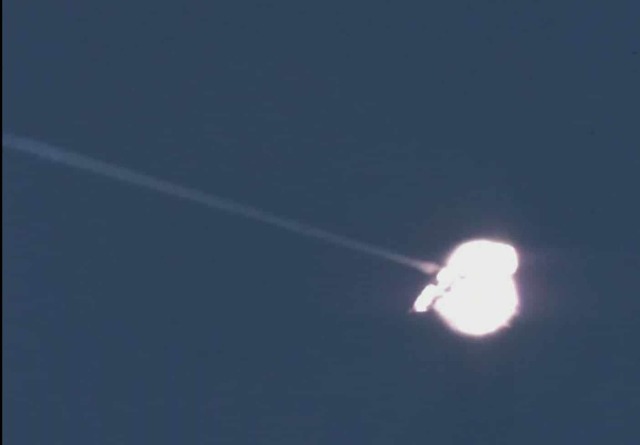Anti-missile weapons are as diverse as the missiles themselves. Among the many complexes and systems there is a very unusual sample. And a successful one, which shot down a real ballistic missile warhead during an intercontinental launch. Perhaps soon this unique system will be adopted. Naked Science reveals all the details about her.
The protection of launch silos with intercontinental missiles has become an important task simultaneously with the appearance of the actual mines. The development of missile protection in the mine went in two directions.
On the one hand, it is strengthening the mine itself and ensuring the safety of the rocket in case of a near nuclear explosion. Thick multi-ton covers covered a solid shaft. The gaps between the rocket and the walls of the mine were large enough that when the ground vibrated with a seismic wave from a nearby thermonuclear explosion, with an amplitude of up to a meter, the displaced walls of the mine did not hit the rocket. This was also provided by the elastic suspension of the rocket in the mine. There were other measures to preserve a combat-ready missile in the event of an explosion that occurred near the mine.
Another part of the protection was designed to prevent a thermonuclear explosion near a missile silo or a silo launcher. In general, in the language of rocket scientists, this is called a BSP — a combat launch position. For positional areas, always located deep in the national territory, enemy aircraft posed a lesser threat compared to missile, since enemy aircraft were more effectively intercepted by air defense means.
The greatest threat to the combat launch site was the warheads of intercontinental ballistic missiles, due to their speed, small size and strategic power. To protect the missile silo from them, in the early 1980s, the USSR developed the concept of echeloned anti-missile protection of a point object (or a separate combat launch position).
The finish line of the warhead
The warheads of intercontinental ballistic missiles in the course of their development changed shape, size and features of movement. After the early generations, with heavily blunted noses and pronounced tail skirts, the American warheads of the 1970s began to look mostly like simple cones.
A conical body in a supersonic flow experiences four components of aerodynamic drag:
- the viscous friction force created by the flow of gas over the surface of the housing;
- the pressure force of compressed gas on the surface of the warhead, manifested in the form of drag;
- wave resistance (through the transfer of energy to the environment by a shock wave);
- and the bottom resistance created by the difference in the static pressure of the atmosphere and the rarefaction that occurs in the bottom area of the warhead. At high altitudes, it is small and almost invisible against the background of other components.
The longer and more needle-shaped the cone of the warhead, the greater the friction force on its long surface. The shorter the warhead and the larger the cone angle, the greater the compression of the counterflow by the hull surface and the braking force of the compressed flow. The minimum of the sum of the braking forces of friction and pressure gives the cone angle in the range of 12-18 degrees and depends on the speed.
American warheads of the 1970s and 1980s came to such forms. They became just a narrow cone, with minimal loss of speed in the atmosphere. And therefore, they maintained near the ground a hypersonic speed of 2-3 kilometers per second.
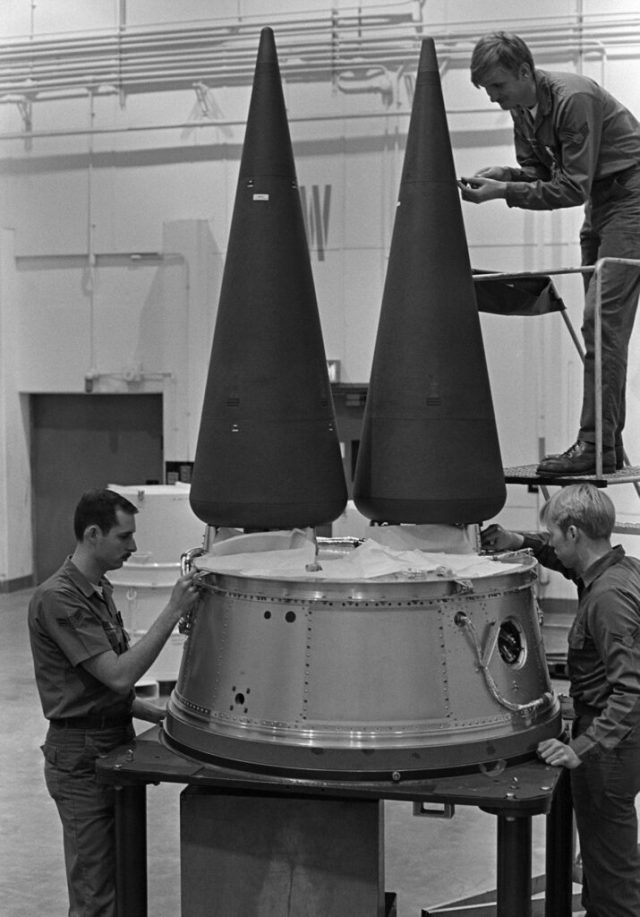
The American W-78 warhead for the Minuteman-3 ballistic missile. The cone angle of the warhead body is 17.8 degrees. The height of the warhead is 1.72 meters, the diameter of the base is 0.54 meters
The movement of the warhead near the target has a characteristic feature. From the point of view of the target, the warhead falling on it has not shifted in the sky for the last ten kilometers. It occupies the same point of the firmament, only getting closer to the goal. The curvature of the intercontinental ballistic trajectory at a scale of 10 km is not felt. This is also facilitated by the huge speed of the fall, which does not allow to significantly bend the trajectory. The warhead moves along the segment connecting it to the target.
The immutability of the point of the firmament occupied by the warhead makes it easier to point an anti-missile at it, starting from a protected missile silo. In a frontal approach situation, the anti-missile does not require vigorous maneuvers and high lateral overloads. It is calmly aimed at a fixed point in the sky with a warhead and flies in a straight line to a rapidly approaching target. This important special case and its advantage is distinguished by the protection of a point object from the protection of a geographical area or a selected territory.
Which racket to stop the ball, or the choice of ways to intercept
The key problem is in another — how and with what to hook the warhead. The shock wave is not good in this case. It quickly (inversely proportional to the square of the radius from the point of explosion) loses force, rapidly diverging from the point of explosion. And the warhead is very resistant to the impact of a shock wave in the forehead — after all, at hypersonic speed, there is already a viscous shock layer on its surface, similar to a stuck shock wave.
Shrapnel damage is much more effective. Therefore, all (except nuclear and related core) anti-aircraft missile warheads are fragmentation, not high-explosive. Striking elements can be both fragments of the body of the warhead, and ready—made, pre-made steel balls or cylinders - but for simplicity, we will continue to call it all just "fragments". Unlike a shock wave propagating in still air, the velocity of the fragments is the sum of the velocity of the rocket and the velocity of the spread from the explosion of the warhead.
Therefore, in order to effectively defeat the target, it is necessary to precisely choose the moment of detonation of the fragmentation warhead, that is, the specific moment and the associated distance to the target. If you blow up the fragmentation part too early, then by the time you meet the target, the cone of fragments will become too rare, with a low probability of defeat. If it is too late to detonate the warhead, its fragmentation cone will not have time to open up enough to hook the target.
And if the target is a warhead with its enormous speed of approach, then determining the critical distance to it and the moment of detonation of the warhead should be very fast. Such a speed of decision-making becomes unbearable for the demolition system, which develops a team to undermine. When the moment of detonation is determined, the distance to the warhead will already change significantly. And while there will be an explosion (it also takes some time, even microscopic, from our point of view), the distance will also change significantly. The high speed of the target makes the blasting system ineffective, not fast enough for rendezvous at such speeds.
A reliable interception would be a direct frontal collision of the kinetic warhead of an anti-missile with the target. It separates from the anti-missile and accurately corrects its trajectory with engines in a small range, combining it with the target. The kinetic warhead does not carry explosives and strikes simply with its kinetic blow, just like a cobblestone launched by a skillful strong hand. Such combat units appeared at the end of the twentieth century and are used for high-altitude and space interceptions.
But the kinetic part requires very precise targeting. And, of course, it is easier for her to get not into a relatively small rocket, but, for example, into a larger satellite of several meters in size. The diameter of the base of the warhead, that is, what the anti-missile "sees" in a frontal attack, is 50-60 centimeters. Such a small target size dramatically reduces the number of chances of hitting.
Echeloned missile defense of the facility
In view of all these difficulties of intercepting the warhead of an intercontinental-range missile (with its enormous speed and small size), it was decided to organize the missile defense of the combat launch site in the form of three consecutive echelons. The first echelon, high-altitude, consisted of anti-aircraft missiles. We will not consider their placement, operation and features of intercepting a warhead here, Naked Science will return to this topic later.
Warheads that passed this echelon harmlessly became targets for the second echelon of defense. It was created by a variety of supersonic anti-tank missiles 9M114 "Cocoon" from the "Sturm" complex. It is difficult to say why this particular rocket was chosen. Perhaps because of the supersonic flight speed, ease of operation, relative cheapness. In the standard version, this anti-tank missile could also hit slow aerial targets such as helicopters, at an altitude of up to 3000 meters, with a missile combat range of 6000 meters (in the "Attack" variant up to 8000 meters). The missile was guided by a command radio link to a stationary or sedentary target. But even an approaching warhead on an oncoming course is stationary in angular terms. This important, key feature of the frontal attack case made it possible to try to use an anti-tank missile against a warhead.
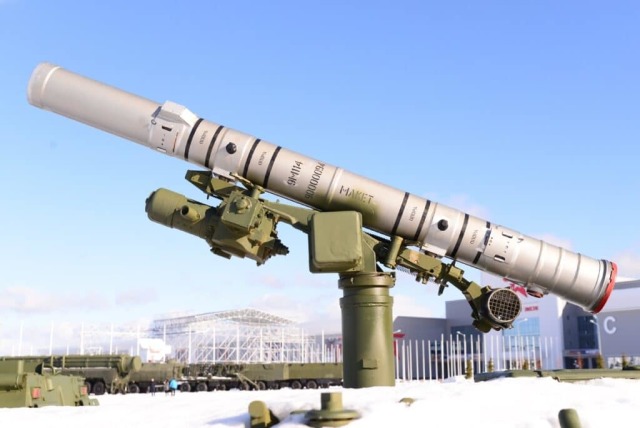
Container with supersonic anti-tank missile 9M114 "Cocoon" from the complex "Storm" / ©kpopov.ru/military
It is also likely that the very principle of low-altitude interception of a warhead by mass inexpensive missiles was worked out on the example of the "Cocoon". It remains unknown what kind of warhead was provided for this on the rocket. It should be noted that the chief designer of the Sturm complex was Sergey Pavlovich Invincible, who headed the Kolomna Design Bureau of Mechanical Engineering — the developer of the Sturm. His deputy at that time, and later the director of the KBM, Nikolai Ivanovich Gushchin, led the development of the third, lower echelon of protection. Later, the project was led by Valery Mikhailovich Kashin. In addition to KBM, many design bureaus and enterprises were involved in the work on the project, a long list of which we will leave out of the story.
Interception at the last mile: echelon of fire at close range
The last 2-3 kilometers of the warhead's flight is a very interesting segment. The multi-ton cover of the mine will protect against the shock wave of a thermonuclear explosion falling from above. Therefore, the warhead will explode not in the air, but on the surface, at the point of impact near the mine. It means that it is not too late to intercept it both at the last kilometer and at the final hundreds of meters.
But the warhead will fall with a miss of the drop point from the mine cover 100-200 meters. Therefore, at the last hundred meters of distance, it will begin to shift in the sky for an observer near the mine. The simplicity of aiming at a fixed point in the sky (with a warhead in it) will disappear. And it will remain stationary or sedentary until it is about a kilometer away.
Therefore, for the simplicity of frontal firing at a warhead fixed in the angular plan, the interception means should be close to the mine. And work on the target at a distance of no closer than a kilometer. That is, the range of the interception range should lie further than a kilometer. And the upper limit should be pushed back to 3-5 kilometers.

A missile silo is a point object of protection. The cover protecting against the shock wave of an air explosion is raised. Photo: ©Wikipedia.
Due to the enormous speed of the warhead and the rapid scattering of fragments, the cost of the detonation system error (and any technical system always works with the current error) becomes too high. And if many missiles can be launched at the upper and middle echelons, consistently attacking the warhead, then there is no time for this at the last couple of kilometers. Guaranteed defeat with a single use of protection is necessary.
Is it possible to make sure that the fragmentation cloud does not scatter in space like a cone? Make a beam of fragments parallel, coherent, like a laser beam that does not diverge to the sides. It would get a long range with a high density of non-dispersing fragments. With such a far-reaching current, one could reach the warhead for a couple of kilometers and sweep it from the sky, like a long mop cobweb in the corner. But the explosion scatters fragments. This is the nature of the released compressed gases — expansion to the sides. And to the sides, they will push apart the steel husk of fragments, and with great speed.
Coherent striking elements will receive a small spread of trajectories, and will maintain a high degree of the same direction of movement for a long time. Their trajectories, precisely and identically formed for each element, will almost not diverge. This will keep the density of the cloud of striking elements at a great distance and for a long time.
You can shoot many bullets at once from many barrels, combined into a common block with one exact direction of the shot. When the bullets lose speed and switch to subsonic falling mode, they will dissipate. Supersonic flows are more stable and introduce less distortion into the trajectory. Therefore, supersonic bullets are more accurate. In order for a coherent supersonic swarm to exist longer and further from the point of the shot, it is necessary to increase its speed and reduce air resistance. It is best to do this by moving from a bullet to a needle-like body, a pointed rod.
A cartridge with an arrow instead of a bullet
The idea of replacing a bullet with a thin needle is not new. In small arms, there are many cartridges that use a thin pointed arrow, or a flechette, instead of a bullet. Being much lighter than a bullet, the arrow gets a much higher muzzle velocity. The thin diameter reduces the air resistance by an order of magnitude. And a large length combined with a small cross-section gives a large transverse load when hitting the target and a high penetrating ability.
However, a thin arrow can no longer be stabilized by twisting — the diameter and moment of inertia are too small, the gyroscope handwheel will not come out of the arrow. Therefore, it is equipped with tail wings-stabilizers. They need to be done precisely so that they do not give a spread of aerodynamic forces and a deterioration of the trajectory. But bullets also require precision manufacturing.
Various types of American experimental cartridges with flechettes. On the incisions, a feathered arrow is visible, in the head part covered with a sabot — an element leading along the trunk channel, painted green on the outside. Photo: http://www.windowssearch-exp.com
Cartridges with arrows have been widely tested in experiments both in America and in Russia. American flechettes were completely placed inside the sleeve and covered in the nose with a special plastic head, or a supporting element — a sabot. The sabot accelerates along the barrel channel with powder gases, like a semicircular plastic green bullet, and pulls the arrow behind it. After exiting the muzzle, the sabot collapses and releases the arrow, which begins free flight. Due to the fact that the arrow is lighter than a bullet, its speed reached 1.4 kilometers per second.
The flechettes were tested in different calibers — both in 5.54 millimeters with different types of sleeve, and in a large-caliber 12.7 millimeters. In the USSR, cartridges with a needle—shaped feathered bullet were also tested of various types - the Dvoryaninov cartridge based on the 7.62 x 54R Mosin rifle cartridge, the Shiryaev cartridge based on an automatic cartridge case and others. Unlike American cartridges with flechettes, the Soviet versions of the arrow protruded from the sabotage point forward.
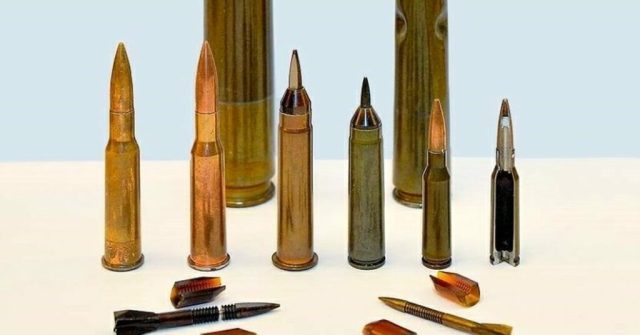
Cartridges of Dvoryaninov (center left) and Shiryaev (center right) with protruding points of arrow-shaped striking elements. The elements themselves are visible at the bottom. Source: pikabu.ru
What was the special ammunition depot hiding
The same look, with a pointed rod sticking forward, as if it were a pencil, was also in the large—caliber special cartridge 14.5 x 114 (in the cartridge formula, the first number means the caliber of the barrel in millimeters, the second - the length of the sleeve). This is the most powerful domestic serial large-caliber cartridge, created back in the Great Patriotic War for anti-tank guns. He successfully fought until victory, and then entered service with large-caliber machine guns KPVT (large-caliber machine gun Vladimirova tank), widely used in the military. Armored personnel carriers have a formidable KPVT barrel with a flame-extinguishing bell sticking out of the tower. Anti-aircraft installations have also been created on the basis of this machine gun. Due to the wide use and long-term production, it is easy to find barrels for this cartridge.
Instead of a bullet, the special cartridge had a sabot of several parts in the muzzle of the sleeve, covering a pointed rod element. The presence of stabilizers-"wings" in its rear part can be confidently assumed — without aerodynamic stabilization, such an arrow will not fly far. The tip stuck out of the cartridge by about ten centimeters, because automatic feeding into the barrel of these special cartridges was not provided.
Carefully sealed in long green boxes, the special cartridges were stored in a separate warehouse of special ammunition. It looked like a small corrugated hangar guarded by a sentry (the special guards were top secret, so they required armed guards). And he was in the forest at the beginning of the road to the technical building of the 14th measuring point. IP-14 itself is located on a forest plain 20 kilometers northwest of the main crater of Shiveluch, the northernmost active Kamchatka volcano, which reared into the sky for several kilometers in a mighty ridge on the eastern macroslope of Kamchatka.
DEEP, unrelated to diplomacy
Measuring points are the eyes and ears of a missile range receiving intercontinental ballistic missile warheads. These are test, training and all other launches, except for combat, which have not yet been in the entire history of the existence of intercontinental missiles. But the actions of the measuring points during all these launches are called combat work.
The equipment of the points measures with high accuracy the actual movement of warheads, the location of their points of fall on the battlefield, deviations of the points of fall from the target, processes on board warheads and many other things. It not only sums up the missile's ballistics by the points of the warheads' fall, but also the work of the warheads' combat equipment.
20 kilometers north of IP-14 on the same wooded plain there was a DIP — an additional measuring point. It was similar in everything to the neighboring IP-14, both in terms of residential buildings and in terms of equipment. Road-street, two-storey buildings, barracks-hotel-power station, food warehouse, medical unit, huge fuel tanks, similar to silver drums; roads to technical facilities where duty shifts go. The same vertical sculptures of sheathed phototheodolites, in combat mode — complex slingshots as tall as a man, flashing lights, snaking cables and buzzing when rewinding the film, the economy of the photo-recording stations of the FRS-2. The same visually strange antenna-feeder devices "Pearl" (we have already told about them), similar to large gray mushrooms with six petals, connected to complexes of receiving and recording equipment of high-speed radio telemetry systems. The only difference is that DEEP still had a satellite, DEEP-1, located a dozen kilometers away from the forest.
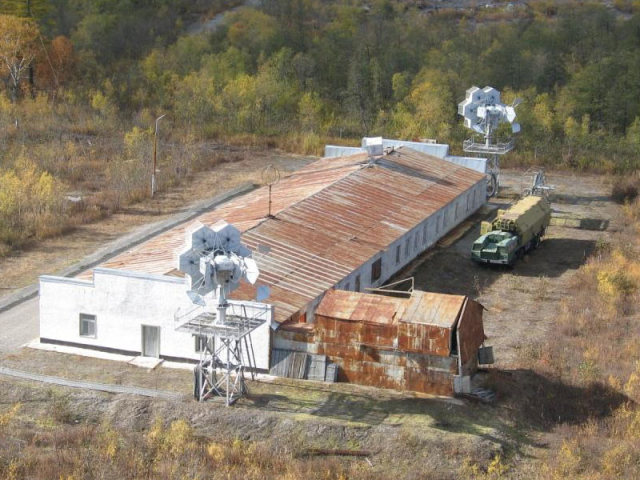
One of the technical buildings on the DEEP. From the ends of the buildings, antenna-feeder devices (AFU) "Pearl" are visible, receiving a telemetry signal from warheads. Photo from the archive http://www.club-polekura.ru
For this purpose, the upper part of the missile silo was built on DEEP-1. And the means of intercepting the warhead were placed around it. During test launches, in which the operation of prototypes of anti-missile systems was checked, not all warheads were aimed at the drop battle field lying to the northeast. Individual warheads were sent to the missile silo layout built on the DEEP-1 and processed by means of one or another echelon, separately. During such tests, all the specialists and personnel who were there were taken out of the DEEP-1.
Organ Quartet and its music
The most interesting was the work of the interception complex of the lower echelon. Special cartridges with rod striking elements were delivered from the special ammunition depot from IP-14 to DEEP-1, where they were loaded into special assemblies. They were 500 trunks combined in a package, like a compact musical organ made of identical pipes.
Each assembly weighed 8 tons and was placed in a deep concrete cup, immersed in the ground and protected by a lid, from where it was extended for firing. There were four such assemblies, placed crosswise, in close proximity around the protected object. All four 500-barrel assemblies were aimed at the target by an automatic control system, without human intervention. The volley shot in the direction of the warhead from 2000 barrels occurred according to a certain algorithm. The salvo formed a stream or a spatial cluster of striking elements moving at high speed towards the incoming warhead. Due to the high energy of the powder charge of the cartridge and the lightness of the arrow, it received a muzzle velocity of about 1.8 kilometers per second. An electric capsule was used to synchronize the volley shot in special cartridges.
Four multiple rocket launchers produced four coherent streams of striking elements converging a couple of kilometers from the mine at very small angles. Due to the small intersection angles, the area of flow alignment, from partial to full and again to partial, turned out to be extended in space, with a length of about a kilometer. A cluster of arrows passed it from the near edge to the far, beyond which the density decreased to ineffective.
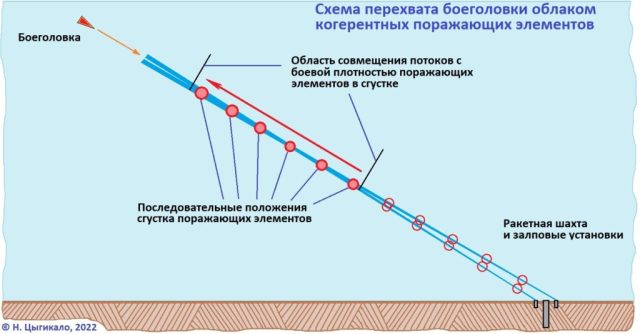
A cloud of damaging elements was fired at the warhead when it was about 5-6 kilometers away. The "meeting" took place at a distance of 2-3 kilometers from the mine. And it could fall on any part of the combat area (combining arrow streams) — in its far part, near or in the middle, so there was no problem of accurately undermining the warhead. And the error in determining the range of the warhead (and, accordingly, the estimated meeting point) could be hundreds of meters without reducing the effectiveness of interception.
This is unthinkable for a fragmentation warhead, but it is quite accessible for a stream of core striking elements. Even with such an error in range, the warhead and the cloud of steel arrows could not miss each other, their meeting was inevitable, except a little further or closer from the mine.
The system worked completely automatically, and a person would not be able to make decisions in such a short time allotted for interception. The direction of the volley and the moment of the shot were calculated by the control system, measurements of the movement of the warhead were carried out by a specially designed radar.
Essays on a free topic
In publications about this complex, which practically repeat each other, errors that occurred in later versions are also transmitted. They are worth noting and separating the grains of reality from the chaff of fantasy.
Firstly, there were no balls that were allegedly used together with arrow-shaped elements. The balls are ordinary buckshot, which has a significant sheaf angle and poor aerodynamics, which not only disperses the sheaf of buckshot, but also quickly slows it down, making it short—lived. This requires high accuracy of the moment of the shot at the last hundred meters, with the risk of not being in time or the risk of too much dilution of the flow of balls. In other words, this is a return to the problem from which the long-range coherent flow of swept elements has fundamentally left.
In addition, it was reported that the size of the balls was "up to 30 millimeters", these are more likely cannonballs, clearly excessive for a warhead with a diameter of 50 centimeters. From which barrels such balls can be fired en masse with a high initial velocity, and it is not at all clear.
Secondly, there is an argument that the arrow-shaped elements would only pierce the warhead, making a sieve out of it, and this is allegedly not enough, complete physical destruction is needed.
But what is interception? In aviation, interception is the termination of a target's flight in the same direction. That is, either the destruction of the target, or a change in its course with a compulsion to land at the specified airfield. In missile defense, interception is also the critical deviation of a missile or warhead from the target point of impact. For example, when Israel intercepted falling Iraqi SCUDS by the Patriot complex in 1991, some of the SCUDS were simply deflected from populated areas, which is considered a successful interception.
But for a nuclear munition with its colossal explosive power, simply deflection is not enough. The interception will be the prevention of a nuclear explosion. Including bringing the charge into a state of inability to explode. An example is the irradiation of the fissile material of a warhead in space by a neutron flux (from a close thermonuclear explosion or by the action of a hypothetical beam weapon creating a neutron flux). The neutrons of the external flow will cause an increase in activity in the fissile material of the nuclear assembly, leading to an earlier energy release when the charge is detonated, and a "thermal zilch" instead of an explosion.
Therefore, a repeatedly pierced warhead with a riddled nuclear assembly, split explosive blocks or with the riddled contents of the automation unit (Naked Science has already told about its dense layout and intense work) is guaranteed to lose its active (nuclear) explosiveness. And this will be a successful interception of it. And it will collapse into pieces a couple of seconds later, by itself, when it hits the surface, with its enormous falling speed.
The high strength of the core elements, which is certainly noted in publications, is also not obvious. Greater strength and hardness makes sense for speeds of impact into an obstacle up to 1.5 kilometers per second. With a further increase in speed, the interaction with the barrier becomes more and more hydrodynamic. At a speed of 2.5–3 kilometers per second, the concept of strength and hardness loses its meaning.
As an example, we can recall the Maroshek anti-tank rifle of the usual German rifle caliber of 7.92 millimeters. It was developed in Poland in 1935 to combat the then prevailing lightly armored vehicles. The cartridge, as long as a pencil (the length of the sleeve is 107 millimeters), was equipped with a bullet with a soft steel shell filled with ordinary antimony lead. And this bullet, without any armor-piercing core or solid element, pierced armor steel with a thickness of 20 millimeters. It's all about the high velocity of the bullet, with a muzzle value of 1270 meters per second. Getting into the armor plate, the bullet flattened, but the energy transmitted to the armor broke through a hole with a diameter of 2-3 centimeters or more, as if by stamping. The armor-piercing action was carried out by soft lead due to the high kinetic energy, and not the cutting properties of the solid armor-piercing element.
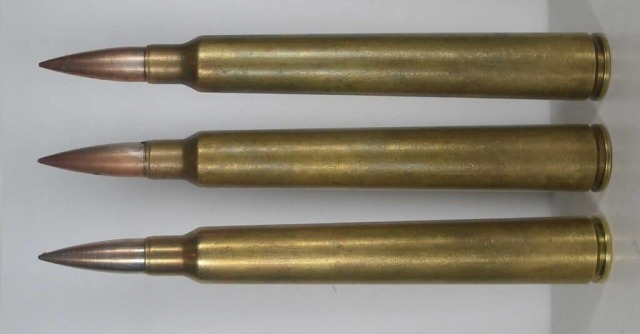
Cartridges for Maroshek's 7.92 mm anti-tank rifle. Photo of the author
The speed of meeting a warhead with striking elements is much higher. Therefore, with such a large value of their kinetic energy, neither the strength nor the hardness of the latter is required for a damaging effect.
Tests of 1987
Tests of the main elements of the middle and lower echelons began in the summer of 1987. Perhaps it is no coincidence that they coincided with the tests of the heavy intercontinental missile 15A18M of the mine-based Voevoda complex, the most powerful in the world. To protect its combat launch position, its missile defense systems could well be useful.
During the test launches of the supersonic missile of the anti-tank complex "Sturm", tracers were hung on it. This made it possible to measure the flight of the rocket by photo-recording stations from the nearest measuring points. The author of this article happened to observe such a launch, being on the roof of the technical building IP-14, near the line of phototheodolites. The work took place during daylight hours. From the line of the forest from the direction to the SOUTH, a small dim light flew obliquely upwards towards the warheads, much weaker than the shining combat unit in its maximum glow. The flight of the glowing dot lasted several seconds. There was no flash of the explosion. The results of the launch remained unknown to the author, but the news of a successful interception would have spread quickly.
A so-called laboratory sample was mounted for testing the multi-barrel complex. An active, shooting practical installation that did not have the completeness of all the envisaged and planned "bells and whistles" of the finished version. At the end of the summer of 1987, during the test launch of an intercontinental missile, one of the warheads flew not into the usual drop square, but into a mock-up of a mine in the DEEP-1 area. A counter salvo of four multi-barrel packages was fired. The interception of the real warhead was successful — it collapsed with a volley shot. Not riddled, remaining intact, but collapsed in the air. The explosive charge on board did not explode, it was simply scattered around the area in small pieces.
Tests were carried out later, until 1991. However, there is no data on the dates and number of tests, as well as their results; it is mentioned that the tests (it is not known which part of them) they were also successful. After 1991, work on the unusual project was discontinued due to lack of funding or political reasons.
"Mozyr": revival and prospects
Only a quarter of a century after the first test, the name of the multi—barrel anti-missile complex - "Mozyr" - leaked into the press. During combat operations, as always, a digital index was used. For the testers, it was primarily a system that successfully intercepted a real intercontinental missile combat unit in a real launch.
Where exactly the rocket launched during the tests, from Plesetsk or Baikonur, is not so important, their range to the area of the fall is comparable, 5800 and 6300 kilometers. Just as the type of missile is not so important, the UR–100 in some modification or the newest heavy 15A18M being tested at the same time. The ballistic differences of launches from these two cosmodromes, as well as the types of missiles that dispersed the warhead to Kamchatka, are insignificant compared to the very fact of successful interception of a warhead with intercontinental motion parameters.
The success speaks of a viable concept of such a point-to-point missile defense. Its relevance remains today, because any warhead will approach the mine in the last kilometers at a high speed in a straight line, reducing the time and zeroing the maneuvering miss.
Therefore, the idea of using a complex with a successful real interception in the test results today is quite natural. To protect the newest Sarmat missile system with a heavy missile, similar in class to the Voivode, a multi-barrel multiple launch complex can become an effective means. Many sources began to write about the fact that the combat launch position of the Sarmat is supposed to be equipped with the Mozyr complex, although not yet official departments that have reliable information.
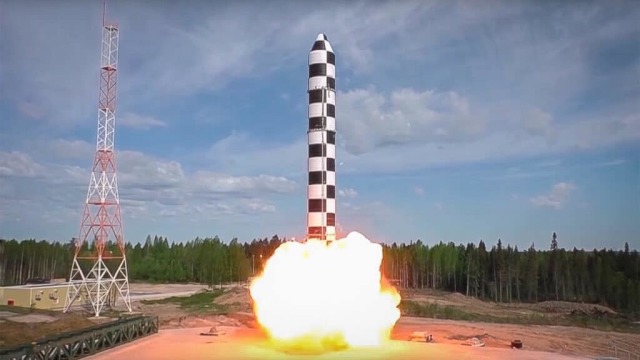
Throwing tests of a heavy ICBM of the Sarmat complex / © Ministry of Defense of the Russian Federation
The revival of the "Mozyr" and its adoption into service will be the logical conclusion of the long history of its creation. Strategic weapons will receive effective protection, and the "Mozyr" itself will be able to develop further, its potential seems quite wide.
For example, a block of trunks can be made mobile by placing it on the chassis, and form the protection of point objects in a modular way. The refinement of the targeting and aiming system can allow the complex to work on low-flying targets. Refinement of reloading to multiple volleys will allow you to shoot down several air targets sequentially, increasing combat capabilities. A separate direction is seen to be used in the fleet to combat anti-ship missiles. Their steep dive in the final section of the trajectory with maximum speed is just the specialization of "Mozyr".
So the revival and development of "Mozyr" can be diverse. How it will turn out in reality, the future will show.
